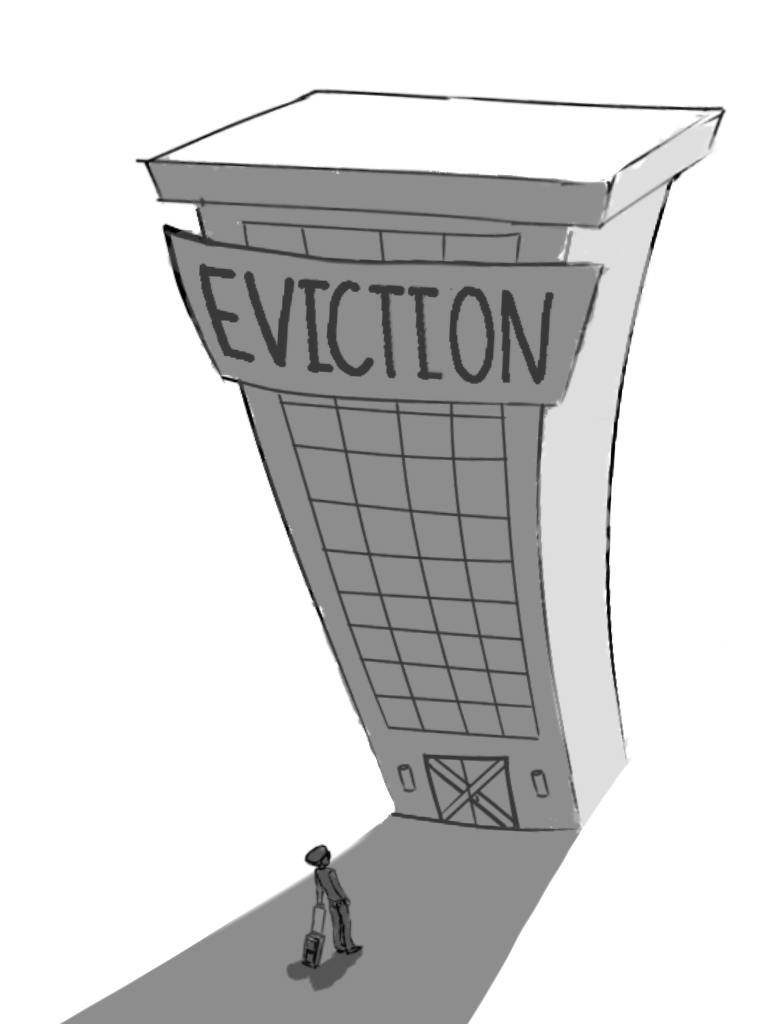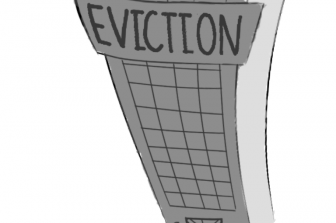
In the last few years, house and rental prices in the Bay Area have skyrocketed. While this is partly due to the recovery from the 2008 recession, the Bay Area’s appealing location with the thriving city of San Francisco in the north and the quickly evolving Silicon Valley in the south is also drawing in more potential tenants. With not enough housing available, the system of supply and demand is raising rent prices, ultimately leading to the eviction of renters who can no longer afford to live in their apartments.
Kyle’s Story
Three years ago, Kyle* and his family were evicted from their apartment. Their landlord saw an opportunity to renovate the building and charge higher rents than the previous tenants could likely afford, thus forcing Kyle and his parents to find a new home.
Kyle recalls, “The landlord gave us three to four months of warning time to work out our living arrangements.” His parents decided to stay at a relative’s house and, from there, look for a new home to move into.
Kyle’s family were tenants of the apartment and had resided in the complex for over seven years. “I lived there for a large portion of my life, so I was attached to it and sad that we had to leave,” says Kyle.
Kyle’s family had no intent to return after the renovation. “The idea had never really struck me. My parents wanted to move on, and even though we really loved the place, it wasn’t reasonable to wait for the renovation and then go back,” says Kyle. While the landlord did not offer the apartment back to Kyle’s family, by the time the renovation was done three months later, they had already found a new home.
Because of the sensitivity and possible embarrassment, Kyle kept his moving plans a secret. “I [didn’t] want to tell anyone else, because I didn’t want unnecessary attention from others. It was just better not to say anything that didn’t need to be said,” says Kyle.
Additionally, Kyle’s parents tried to remain as normal as possible. “I would remember when my mom would drive me to school that it was just like any other day, so nothing really felt different because everyone acted the same way,” he says.
Fortunately for Kyle, being evicted didn’t have a great impact on his school life. “I still went to school and lived a normal life. I did my homework and wasn’t really bothered by anything,” recalls Kyle. Grades were a fundamental priority for Kyle, and he always made sure to keep up with his schoolwork.
“My parents really impressed upon me that I would still need to work as hard and not slack off in school just because we were going through some changes,” says Kyle. “Deep down I was upset that I had to leave a place I lived most of my life, and [disliked the] unnecessary stress it caused my parents, but I didn’t bring what was at home to school.”
In retrospect, Kyle says, “Eviction is a difficult process and I was fortunate enough to have an easier time with it. I didn’t have to worry about financial problems [that affect] most people who are evicted.”
Homelessness and Aragon
However, for students less fortunate than Kyle, eviction can be a harrowing experience that detracts from the quality of their learning at school. For students who are homeless for longer periods of time, Aragon Student Services does everything it can to make students comfortable.
“It’s delicate and hard to deal with, so we have to be sensitive to every person’s situation,” says assistant principal Joe Mahood. “If a student is homeless, we as a school are legally obliged to help them in every way.”
The McKinney-Vento Act requires every school district to provide homeless students with equal access to public education. “If they declare themselves to be homeless, they are eligible to attend any high school in the district,” says Mahood. “We provide free lunch, and if they need supplies or necessities for school, we provide [those] for them.”
Privacy is one of the most important aspects in dealing with the sensitive issue. “It is case-by-case and we try to take care of students as privately as possible. Depending on what they need, we get it for them,” says Mahood.
College Housing
Housing in the Bay Area is one of the most expensive in the country, so finding places to live is especially difficult for college students.
Aragon alumna and University of San Francisco sophomore Nicole Sanchez currently rents an apartment with friends in the Presidio, about three miles away from school.
“For me, living off campus is cheaper than living on campus. Food on campus is insanely expensive and my rent is much less expensive than dorm life … My rent is about $600 to share a room,” Sanchez says. “It blows my mind how much people are willing to pay for the convenience of a one to two block walk to school, and that goes up to $1500 for a room to themselves.”
However, finding housing that a college student can afford in the city can be difficult. “It’s a struggle to find ‘affordable’ off-campus housing, like apartments or full houses, but we make do with what we find,” Sanchez says.
Even with an affordable apartment, Sanchez still admits that costs can add up for a college student.
“I’m lucky to have found friends with an open room and a renewable lease at probably the lowest rent you’d ever find [in San Francisco]. But most rent comes up extremely high. A struggle I know students coming from lower-middle to middle class families experience is finding roommates within the same budget range,” she says. “Students come from all backgrounds and sometimes don’t understand the financial needs and barriers that come with going to school [and accessing] food or shelter.”
Although Sanchez and her roommates have not faced eviction, Sanchez sees the effects of the high price of living in the city through her volunteer work.
“[The issue of permanent housing] is absolutely apparent in the neighborhood I intern at,” says Sanchez. “I work at a non-profit arts organization called Kearny Street Workshop and it’s part of a larger Asian Pacific American/Filipino community in South of Market. Families are currently experiencing a mass [displacement of tenants] called the 5M Project and it’s completely wiping out an ethnic community of Filipinos, African Americans, and Chinese families in the area.”
San Mateo Rentals
San Mateo’s close proximity to San Francisco and Silicon Valley, in addition to the high quality of life in the Bay Area, has been drawing in new tenants.
“It has a lot to do with young people getting out of college and moving into apartments. It’s the millennials, it’s the baby boomers’ kids, so that’s just a huge group of people who are all looking for housing at the same time,” says Sandy Council, San Mateo’s Neighborhood Improvement and Housing Manager. “There’s so much [demand] for housing and we haven’t been able to keep pace at this point.”
Because the demand for housing is high and the amount of available housing is scarce, landlords have been raising rent prices. As of June 30, the average market rent for a two bedroom apartment in San Mateo County is $2,815. According to the county’s Housing Department, this is a 12.5 percent increase from last year, and a 49 percent increase from just four years ago. Landlords typically expect tenants’ incomes to be about two and a half times the rent, and these new figures require a household income of over $85,000 to be eligible for the average unit. Longtime residents and working families are being forced to double up on jobs or move out of the area once they are faced with a large rent increase or eviction notice to vacate.
However, as in Kyle’s case, renovation is another contributor to the rise of evictions. “The landlords, they’re looking on Craigslist and they’re like ‘Oh my gosh, somebody down the street from me is renting the apartment for a lot more than I am,’” Council says.
In order to renovate their older buildings, landlords must evict all their tenants to do construction, like what was done with Kyle’s family. “They’ll clean everything, and they’ll renovate and make it really nice, and they’re able to rent their unit for a lot more than they were able to before,” says Council.
Evictions like these are known as “no-cause,” since the tenants have not been evicted for a cause that can be considered “just” or fair. Thus, one possible solution to this growing eviction problem is the implementation of a “just-cause eviction” program. Currently, landowners are able to remove a tenant by canceling the rental agreement with substantial prior notice, or when the lease is up. “You can’t tell Mr. Smith to leave unless Mr. Smith has done something to violate the lease. So Mr. Smith can’t pay his rent, or he damages the building, he has misconduct, or there’s some valid reason to the tenant, you can, but as long as he sitting there and being a good tenant you can’t just go out and evict them,” Council explains. “That has been proposed, but I don’t know whether our council will adopt that or not. It’s not very common, but it’s one tool that’s been suggested.”
Another solution is a tenant relocation program, where tenants are given a payment by landowners to find temporary housing elsewhere, until renovation is completed. In addition, the San Mateo council has suggested that landowners offer old renters first priority on moving back in after the renovations are finished.
However, these solutions do not fix the true problem. “Just-cause and tenant relocation don’t address the fact that now the landowner renovated the building, he’s going to increase the rent, so now people can’t afford it and people can’t move back in,” says Council.
Currently, San Mateo City Council and board members are working hard to implement solutions that will help resolve the housing dilemma, hence lowering eviction rates and providing care for victims. “All the solutions are complicated, and all the suggestions are complicated, and [there are] going to be pros and cons to both,” says Council.




